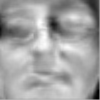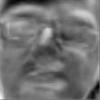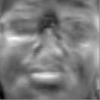How many eigenfaces to use?
From the graph we see that as we increase the number of eigenfaces
considered, the recognition improves but later on it is seen to
saturate. Using more number of eigenfaces requires more time while
recognition. So there is a trade off between the speed and accuracy. I
also think that using more and more eigenfaces will tend to overfit the
system which might not be good when we want to detect faces which are
not in the database.
The number of eigenfaces to be used can be decided by looking at the
eigenvalues. The eigenvectors corresponding to small eigenvalues only
contain information about detailed differences in comparison to a
higher level discrimination by the eigenvectors with larger
eigenvalues. We can choose to remove the vectors with smaller
eigenvalues without affecting the results by a great amount. Hence one
way to do this will be to sort the eigenvalues in descending order and
plot them as shown below.

As seen, the change in the
eigenvalues diminishes after around the index 10 or 11. Hence this
might be the good choice for the number of eigenvectors to be used.
As observed from the recognition accuracy graph, we do get a lot of
wrong matches. Most of the times, the correct answer did appear among
the top few results for the match.
Examples:
 |
 |
 |
| query |
rank 1 |
rank 2
(correct) |
 |
 |
 |
| query |
rank 1 |
rank 4
(correct) |
In the second example, the matched faces do look quite similar. (Maybe that's an understatement!)
The mistakes are sometimes good as in the second example and bad as in
the first example. In general, it is observed that the system does a
reasonable job.
Face detection using eigenfaces
Generating Skin image
I implemented a naive skin detection system first based on the color
range values. The color constraints on a pixel to be a skin pixel are -
(R>=1.2*G) AND (G<=8*B) && (G>=0.9*B) && (R<=2.8*G)
To take care of the color noise, I check this constraint over a 11X11
patch centered around that pixel and accordingly make it a potential
candidate for a face. This detection works quite well as seen below:
Original Image
"Skin" image (gray values indicate face detection error)
This criterion for skin was empirically set and it is not validated
over a big database. Ideally, we need to do some kind of learning on
the data we are processing since a single skin color model will not fit
people from any geographical location. This is noted in one of the
examples later.
Generating Facial Skin image
For face detection, I go one step further and filter potential
face candidates based on the number of skin pixels in the patch. This
stage is useful to remove the effect of color aggregation in the
patch-based method in the previous stage. This threshold has been
empirically set to 0.1. So the assumption is that any rectangular patch
can be a face only if it has 90% skin pixels inside it. The threshold
of 0.1 is quite strict in the sense that it does not
allow people to have facial hair. If we want to take care of that, we
have to loosen this criterion by increasing the threshold.
Thus this threshold can be seen as the maximum portion of face covered with hair.
The skin image after this filtering looks like the following:

"Facial Skin" image (gray values indicate face detection error). Facial hair threshold: 0.1
Notice that most false positives from the skin image go away
Now that we have the potential candidates, we compute the errors on
forward and back projections of the candidate on the eigenspace. We
choose the top results from this. Also, we take care that any two
resulting faces do not overlap with each other much. This overlap is
checked by computing distance between the centres of the patches. If
this distance is less than 50 pixels, then we choose the better one and
discard the other. This threshold has been hardcoded as of now and will
have to depend on the expected density of faces in the image.
The following image shows the detected faces in the image (scale: 0.3, top 15 faces).
Top 15 detected faces (has some false positives)
To see the effect of the
facial hair threshold, consider the following image:
 |
 |
| Has no "facial skin" with threshold 0.1 |
Faces detected after threshold increased to 0.4 |
min_scale=0.45, max_scale=0.55, step=0.01
Examples of cropped faces:
|

min_scale=0.45
max_scale=0.55
step=0.01 |

|

min_scale=0.3
max_scale=0.5
step=0.1 |

|

min_scale=0.3
max_scale=0.5
step=0.1 |
More examples of face detection in group photos
 min_scale=0.45, max_scale=0.55, step=0.01, facial_threshold=0.1
min_scale=0.45, max_scale=0.55, step=0.01, facial_threshold=0.1
 min_scale=0.65, max_scale=0.85, step=0.1,
facial_threshold=0.4. In this example, I had to augment the skin
criterion with a minimum threshold on RGB each. Also, the left most
face does not appear in the top 9 faces because of a false positive
else where. But it does come up when we choose top 10 faces instead.
Also, it seems having illumination changes on the face makes a
difference. Here the faces are illuminated from their left side and
where this effect is more, the system makes some mistakes.
min_scale=0.65, max_scale=0.85, step=0.1,
facial_threshold=0.4. In this example, I had to augment the skin
criterion with a minimum threshold on RGB each. Also, the left most
face does not appear in the top 9 faces because of a false positive
else where. But it does come up when we choose top 10 faces instead.
Also, it seems having illumination changes on the face makes a
difference. Here the faces are illuminated from their left side and
where this effect is more, the system makes some mistakes.
Choice of scale parameters: In
most of my experiments, the following parameters worked well:
min_scale=0.3 max_scale=0.7 step=0.05. This is an exhaustive interval
over which my images worked well. The interval and step size can be
varied by having some estimates about the size of the faces in the
image.
Mistakes in face detection -
Face detection is not fool proof. During the experimentation I did
observe false positives which in turn cause some proper faces to not
appear in the final rankings. This is mainly because of the loose
training
of the system. I also tried using a normalization phase before PCA
where I multiplied the MSE by the ratio of distance from mean to
standard deviation. But somehow I did not observe an improvement. I
think that was the case because the standard deviation is computed only
on a small set of observations and is not accurate. There are many
parameters in the system and I think that using priors from the data
will improve the system.
Face morphing
Exaggerating the differences between the two faces by making them move
away from each other in the eigenspace just seems to increase contrast.
It does not make much sense to me.
Extra Credit
1. Skin detection using color cues
2. Facial skin detection using voting based mechanism on skin patches
3. Implemented the speedup mentioned on the course web page for computing eigenfaces
4. Face morphing
